Originally published on SoundStage! Xperience
Quebec’s Simaudio has been designing and manufacturing audio electronics for the past 35 years. The company began with preamplifiers and power amplifiers, and later, following the demands of the market, added CD players and standalone digital-to-analog converters (DACs). More recently, Simaudio has launched a series of components incorporating their Moon intelligent Network Device (MiND) platform, which enables streaming audio from your computer, network-attached storage (NAS) device, or the Internet. It should come as no surprise, then, that Simaudio has brought their electronics-design experience to the thriving market of headphone audio -- with first their flagship 430HA fully balanced headphone amplifier ($3500 USD; add $800 for DAC option), and now the subject of this review, the more modestly priced Moon Neo 230HAD ($1500 including DAC).
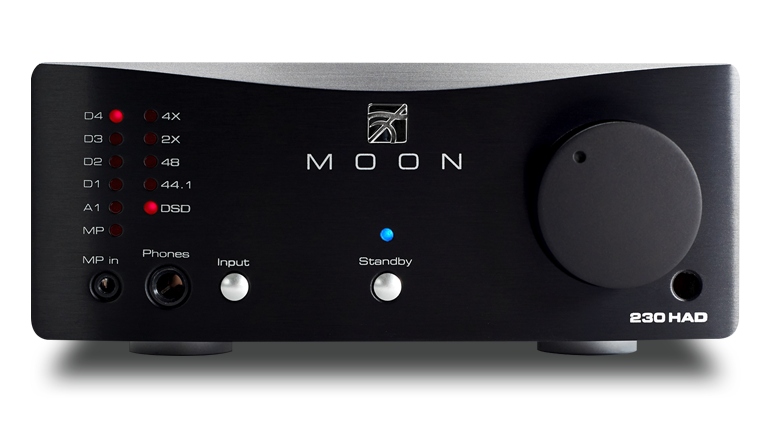
Description
Physically, the Moon Neo 230HAD is a compact box measuring 7”W x 3”H x 11”D and weighing a svelte 6.2 pounds. While its anodized aluminum case is nicely put together, the 230HAD’s utilitarian appearance is unlikely to win any design competitions. Front-panel controls consist of a Standby button, an Input button for source selection, and a large, smoothly turning Volume knob; all of these functions are duplicated on the remote control. Lights on the front panel indicate the source selected and the sample frequency of the incoming digital datastream.
Rather than being merely a DAC with an output stage capable of driving headphones, the 230HAD is an analog amplifier to which a DAC has been added -- an architecture that permits analog as well as digital inputs. The 14dB of gain on offer should be more than enough for any reasonable analog source, and, conveniently, in addition to the analog input on RCA jacks on the rear panel, there’s a front-panel 1/8” stereo input jack for the easy connection of smartphones and other media players.
Nor has Simaudio skimped on the digital side. The 230HAD has four digital inputs: one TosLink, two coaxial, one USB. The TosLink and coaxial inputs support bit depths up to 24 and sampling frequencies up to 192kHz, while the USB input extends support to 32 bits and 384kHz, as well as DSD up to 4x (DSD256). As usual, Apple OS X users need only plug in the 230HAD; we Windows users must download and install a driver from Simaudio. Fortunately, installing the driver was a painless process; I was up and running in a matter of minutes.
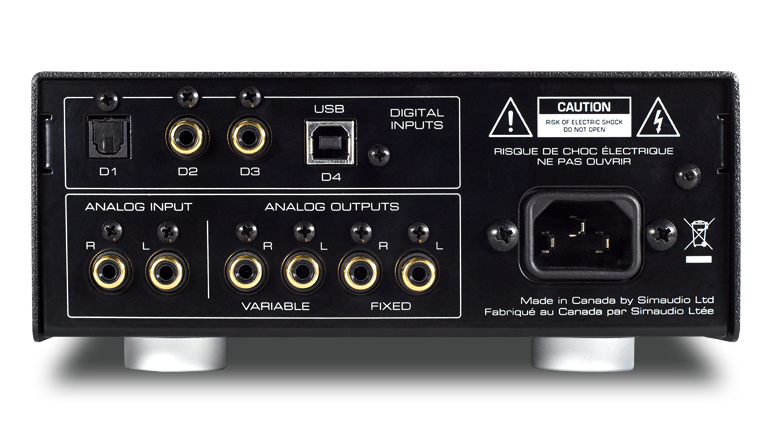
The 230HAD’s digital section is based on an ESS Technology ES9018K2M chip. The USB input works in asynchronous mode -- in which the timing is entirely controlled by the clock in the DAC -- and both the TosLink and coaxial inputs are asynchronously upconverted. I did most of my listening through the USB input, but also connected my Harman/Kardon CDR 25 CD player/recorder via a coaxial digital cable (my usual Ayre Acoustics C-5xeMP CD player has only an AES/EBU output), in order to listen to unripped CDs.
For outputs, the 230HAD has a single 1/4” standard stereo headphone jack on the front panel, and both fixed and variable single-ended outputs on RCA connectors around back -- if you primarily use digital sources and don’t need a phono stage, the 230HAD can easily function as your only preamplifier. Plugging in a pair of headphones doesn’t mute the rear-panel outputs, and there’s no switch to do so -- which I sometimes found annoying.
The amplifier gets its power from a 10VA toroidal transformer with 13,200µF of capacitance, for smoothing and power reserves, and four regulation stages for each of the analog and digital sections.
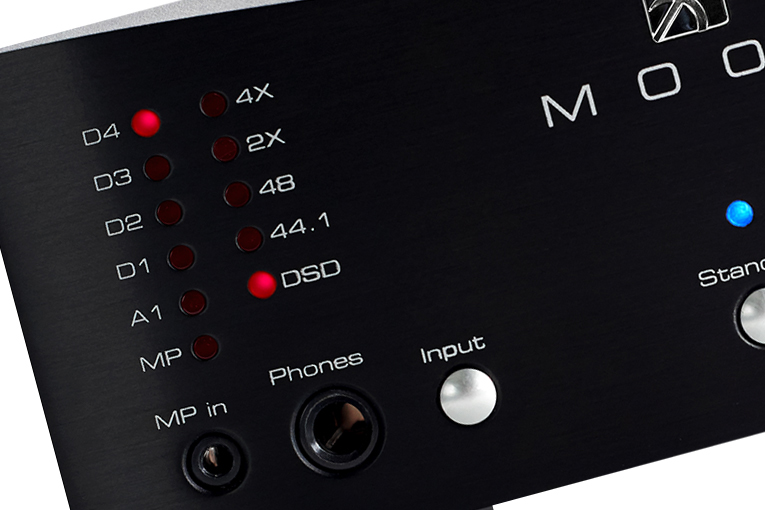
Simaudio specifies the Moon Neo 230HAD as being compatible with headphones ranging in impedance from 20 to 600 ohms, with maximum outputs of 100mW into 600 ohms and 1W into 50 ohms -- enough power to drive any reasonably sensitive pair of headphones to deafening levels. Of equal or greater importance is the specified output impedance of 1.25 ohms, which is low enough not to alter the frequency response of headphones with significant impedance swings. The 230HAD’s frequency response is given as +/-0.1dB, 20Hz-20kHz, and +0/-3dB, 5Hz-100kHz. The signal/noise ratio is claimed to be 115dB (20Hz-20kHz) at full power, with both total harmonic distortion and intermodulation distortion measuring less than 0.005%. All of these numbers suggest electronics that will get out of the way of the music.
Sound
The aspect of the Moon Neo 230HAD’s sound that grabbed me on first listen, and one I continued to appreciate throughout the review period, was the sense of space -- particularly depth -- it conveyed with the right recordings. In “Mining for Gold,” from the Cowboy Junkies’ The Trinity Session (16-bit/44.1kHz FLAC, RCA), Margo Timmins’s voice was present and palpable at the center of the soundstage, its reverberations slowly fading into the acoustic of Toronto’s Church of the Holy Trinity, and the clanking and clunking of the church’s heating system seeming to come from far off in another world.
This excellent re-creation of spatial cues was also a boon to great orchestral recordings. For example, with Neeme Järvi and the Gothenburg Symphony Orchestra’s reading of Tchaikovsky’s Symphony No.4 (24/96 FLAC, BIS/eClassical), I heard the string section up around me, and the brass noticeably farther out in front of me -- as if I were standing at the conductor’s podium. Precise re-creation of ambience is not generally as important with studio recordings, but, through the 230HAD, I could clearly hear that Omar Hakim’s drum set in “Touch,” from Daft Punk’s Random Access Memories (24/88.2 FLAC, Columbia Édition Studio Masters), was the real thing, recorded in a real space, rather than an assemblage of synthesized samples -- it existed in a separate acoustic envelope within the mix. With “Hello,” from Adele’s 25 (16/44.1 FLAC, XL Recordings), the 230HAD clearly resolved the reverb around her voice in the opening, and when the song transitions into the B section, the expansion of the soundstage was huge. Further, this sense of space was equally apparent whether I was listening through good headphones, or was using the 230HAD as a DAC feeding my usual stereo setup.
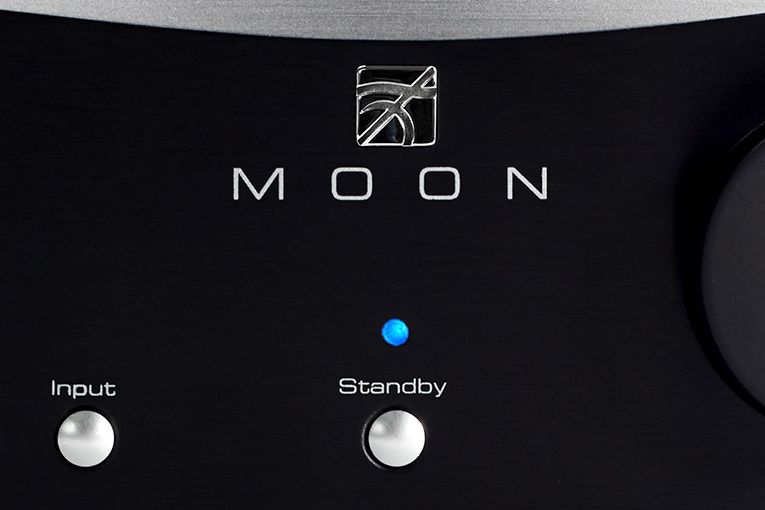
Another notable characteristic of the 230HAD’s sound was its bass. Both the Audeze LCD-X and Oppo Digital PM-1 headphones are capable of prodigious bass, and the 230HAD brought forth a low end that was not only abundant, but clean and well controlled. The kick drum in “Lose Yourself to Dance,” from Random Access Memories, was simultaneously fat and punchy, and the bass-drum strokes in the final movement of Tchaikovsky’s Fourth seemed to draw on limitless power. The 230HAD also maintained excellent tunefulness with Dave Holland’s double bass on his Extended Play: Live at Birdland (CD, ECM 1864/65), and good pitch definition in the bottom octaves of the piano in Menahem Pressler’s Vienna Tales, a recital album of music by Schubert, Mozart, and Beethoven (24/96 FLAC, La Dolce Volta/eclassical). However, whether through the 230HAD’s headphone or line-level output, the middle-low bass -- where electric- and double-bass energy is concentrated -- seemed a touch elevated relative to strict neutrality. With much music and ancillary equipment, this characteristic could be heard to add a pleasant dollop of extra weightiness. But with recordings that already have prominent bass, such as Shelby Lynne’s Just a Little Lovin’ (CD, Lost Highway B0009789-02), I occasionally wondered if it might be slightly too much of a good thing.
At the other end of the audioband, the 230HAD sounded clean and appreciably extended, but balanced toward the gentle rather than the bright and edgy. With Vivaldi’s “che giova il sospirar,” from the TWBAS 2012 Sampler (24/176.4 FLAC, 2L/SoundStageRecordings.com), individual notes in the harpsichord had crisp but not exaggerated transients, and chords never sounded brash. In the same piece, when they entered, the violins sounded lively without turning too aggressive. On the other hand, Mira Tujakbrojewa’s violin in Efrem Zimbalist’s Fantasy for Violin and Piano on Rimsky-Korsakov’s Coq d’or (CD, ARS Produktion ARS 38 009) was just a fraction too smooth and sweet, slightly damping some of the fire this piece calls for. The production values of Adele’s 25 are better than those of her 21, but the full-chorus sections with backing vocals in “Hello” are still a little too hot. With such recordings, which constitute the bulk of modern popular releases, the 230HAD’s forgiving top end made listening a much more pleasurable experience.
The 230HAD’s well-developed low end and relaxed top were complemented by a midrange that was full-bodied and colorful without giving up neutrality. From Thomas Hampson’s rich baritone to Susan Graham’s brilliantly clear mezzo-soprano, in a collection of Mahler’s orchestral songs with Michael Tilson Thomas and the San Francisco Symphony (SACD/CD, San Francisco Symphony 82193-60036-2), to Sade Adu’s smooth and sultry tones on her Diamond Life (16/44.1 FLAC, Portrait), voices displayed real depth and complexity. The 230HAD also respected the uniqueness of instrumental timbres, making it easy to follow individual parts in orchestral works.
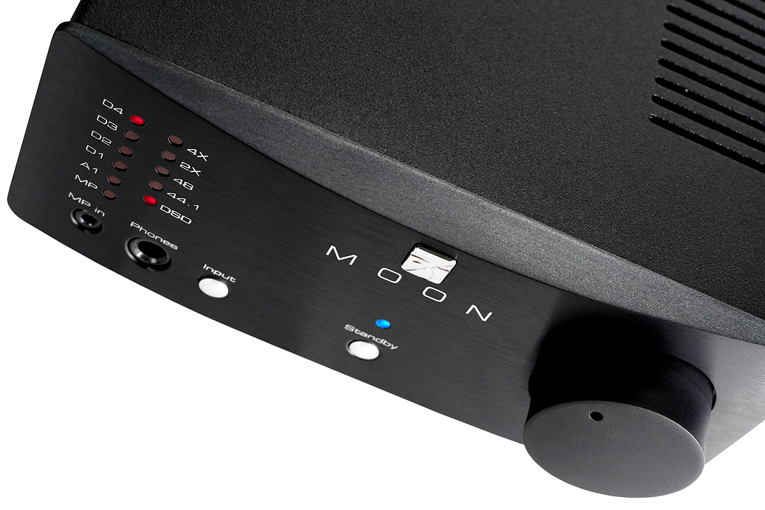
Finally, although the 230HAD didn’t have a tipped-up high end to heighten the sense of detail, that didn’t mean the details weren’t there. In the Mahler recording, the strokes of the beater against the triangle, the bouncing of the string players’ bows against the strings in the col legno passages, and Susan Graham’s precise German diction were all readily apparent and rendered in an unforced manner, never artificially highlighted. Returning to The Trinity Session, the 230HAD’s low noise floor was what allowed me to hear, at the end of each song, the natural decay of the instruments fading -- not into total silence, but into the background sounds of the church. While it’s possible to achieve even greater levels of resolution, that generally comes from significantly more expensive DACs, such as the Resonessence Labs Invicta ($4995). The Moon Neo 230HAD rarely left me wanting in this regard.
Comparison
Despite the number of headphone amplifiers that have been through my listening room over the years, my reference remains Grace Design’s m902 ($1695, now discontinued). The m902 has more features than the Moon Neo 230HAD -- including balanced analog inputs, an analog volume control that operates in steps of 0.5dB, a balance control, a crossfeed circuit, independent control of the headphone and line outputs, and two headphone outputs (though these are not independently controllable). The latest version, the m920 ($1895), adds a balanced analog output and a mono switch, along with upgrades to the amplification circuit and DAC section, the latter now employing a chip from ESS Technology and giving three digital filter options. It’s also built into a smaller enclosure than the 230HAD, but whether that’s good or bad will depend on personal preference, and how and where it’s used.
Converting digital signals to analog has continued to improve in the decade since the m902’s launch, so I see no point in comparing its DAC section to the 230HAD’s. Instead, I connected the single-ended analog outputs of my Ayre C-5xeMP into each, and also experimented with using the Simaudio as a DAC into the Grace’s analog inputs. I left the m902’s crossfeed circuit off. The differences in the headphone amps’ sounds were less about absolute quality than character, and the most noticeable of these character differences was in the bass. The m902 had excellent extension and tunefulness, as well as punch when called for, but the 230HAD simply had more bass, which gave the sound extra robustness. Through the Grace, however, there was more space around individual notes from the double basses in the Mahler, and the lowest notes of the concert harp were slightly better separated from the surrounding acoustic. Either amplifier was more than capable of driving all of the headphones I had on hand, but the extra midbass from the Simaudio often made it sound somewhat more powerful.
The m902’s high frequencies were a touch more extended and delicate than the 230HAD’s, letting the triangle in the Mahler ring more freely, and giving more shimmer to the cymbals in “Sally,” from Diamond Life. Whether due to explicit differences in the high end, or to the Simaudio’s tonal center residing lower than the Grace’s, brass instruments tended to sound slightly brassier through the m902, more burnished through the 230HAD. But while the Grace by no means sounds bright, it doesn’t offer the Simaudio’s forgiveness of overly hot recordings -- which is perhaps more appropriate to its professional pedigree.
Last, both headphone amplifiers did a fine job of preserving the soundstage width and depth furnished them by the Ayre. This indicates that the 230HAD’s exceptional reproduction of depth is the work of its DAC section, and that the rest of its circuitry is simply doing its part to preserve what’s there.
Conclusion
At $1500, Simaudio’s Moon Neo 230HAD enters a competitive segment of the market in headphone DAC-amplifiers. Its multiple analog and digital inputs, multiple analog outputs, well-specified DAC, and remote control, while comprising a list of features not as long as those of some pro-audio models, cover the features that most audiophiles need and want. The 230HAD doesn’t offer balanced drive or extreme power, as does its larger, more expensive sibling, the Moon Neo 430HA, but these options are relevant only with a small number of very high-end headphones.
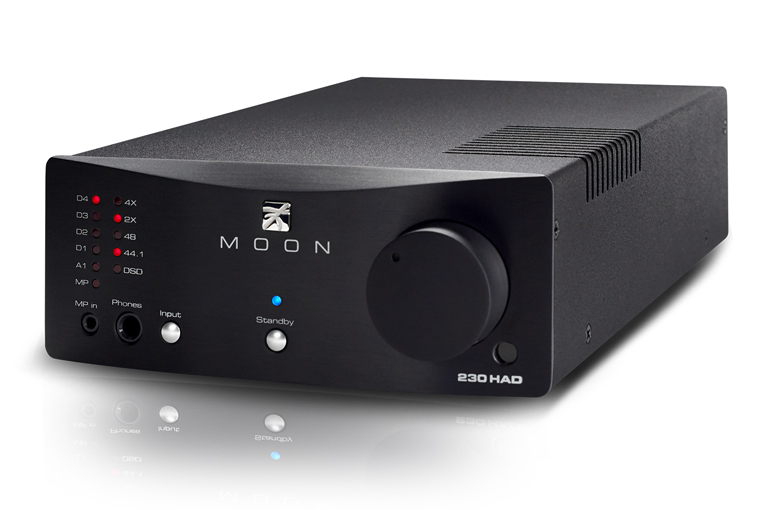
Of equal or greater importance is the Moon Neo 230HAD’s sound. While any competently designed solid-state headphone amp should produce a sound that’s close to neutral, audiophiles base their buying decisions on the subtler ways in which amplifiers differ. The 230HAD has prominent but controlled bass, relaxed and refined treble, and a full-bodied midrange that provides a coherent transition between the two -- a sonic profile I found worked well with all types of music and a variety of headphones. Perhaps most notable was the 230HAD’s reproduction of space -- something often lacking in the headphone outputs of portable players and DACs alike. Add a ten-year warranty from a company with a good reputation, and Simaudio’s Moon Neo 230HAD is a very solid value.
. . . S. Andrea Sundaram
Associated Equipment
- Digital sources -- Ayre Acoustics C-5xeMP, Harman/Kardon CDR 25 (used as transport)
- Headphone amplifier -- Grace Design m902
- Headphones -- Audeze LCD-X, NAD Viso HP50, Oppo Digital PM-1, Ultrasone Pro 2900
- Amplifier -- Graaf GM50
- Speakers -- Esoteric MG-10
- Subwoofer -- REL R-328
- Interconnects -- DH Labs Revelation, QED Silver Spiral
- Power conditioner -- Equi=Tech Son of Q
Moon by Simaudio Neo 230HAD DAC-Headphone Amplifier
Price: $1500 USD.
Warranty: Ten years parts and labor.
Simaudio Ltd.
1345 Newton Road
Boucherville, Quebec J4B 5H2
Canada
Phone: (450) 449-2212
Website: www.simaudio.com







